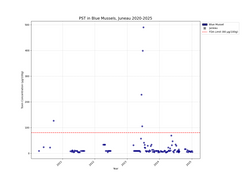

Please feel free to explore our previous research below
Latest PSP Results Data Sheet
Resources (Links to Documents)
Academic Papers (links for papers below)
-
Saxitoxin and tetrodotoxin bioavailability increases in future oceans
-
Saxitoxin in Alaskan commercial crab species (Online Article)
Contacts
Knik Tribe
Jackie McConnell
Environmental Project Coordinator
907-982-5282
Partners
Paralytic Shellfish Poisoning (PSP)
Knik Tribe's Natural Resources Department
About the Project
The Knik Tribe is leading the Paralytic Shellfish Poisoning (PSP) Risk Management Project, a comprehensive initiative supporting multiple Alaskan Tribes and public health agencies, including the Alaska Department of Environmental Conservation (ADEC) Environmental Health Laboratory.
What is PSP?
PSP is usually caused by the consumption of bivalves (clams, mussels, scallops) contaminated with paralytic shellfish toxins (PST). PSTs are produced by the microscopic marine dinoflagellate Alexandrium. Alexandrium PSTs bioaccumulates in shellfish and other marine organisms. These toxins pose a serious public health risk to people that rely on marine resources.
Why PSP Monitoring is important?
PSP poses a risk to coastal Alaskan communities, due to the reliance on shellfish for subsistence and cultural uses. As subsistence users, many Alaskans rely on their local knowledge to determine whether it is safe to consume shellfish. Local knowledge presumes that PSP occurrence is solely a summer event and may be identified by a red color in the water termed a “red tide,” however, these are not necessarily true. Most Alexandrium blooms are colorless, and shellfish species may retain their toxins long after a bloom has occurred. Additionally, the risk of PSP cannot be removed by cooking or freezing contaminated shellfish or other PST contaminated biota and has been responsible for five deaths and over 100 cases of PSP in Alaska since 1993 (State of Alaska, 2022). To reduce the risk of PSP, individuals are encouraged to contact the Knik Tribe to coordinate sending samples in for testing. The toxicity results will help inform about toxicity risks.

How we monitor?
The Knik Tribe’s project, funded through 2026, is dedicated to monitoring and quantifying paralytic shellfish toxins (PSTs) in Alaska’s marine ecosystems. Weekly blue mussel samples are collected from eight key locations: Akutan, Chignik Lagoon, Juneau, King Cove, Old Harbor (Kodiak Island), Kodiak (the city), Sand Point, and Unalaska. Additionally, opportunistic subsistence-harvested bivalves (such as clams) and other marine resources, including salmon, various fish species, crabs, and other invertebrates, are tested for PSTs and domoic acid. These samples are contributed by local harvesters and state agencies, allowing for an extensive analysis across species and regions in Alaska. Different species accumulate and expel these toxins at different rates. Blue mussels (Mytilus trossulus) are known to accumulate and depurate PSTs relatively quickly, often within days to weeks. This makes them a valuable sentinel species for indicating the occurrence of harmful algal blooms (HABs).

 |  |  |
|---|---|---|
 |  |  |
 |  |

Contact Us
Email: info@kniktribe.org
Tel: 907-373-7991
ICWA Fax: 907-373-2153
Main Fax: 907-373-2178
Admin Fax: 907-373-2161
Physical Address
1744 North Prospect
Palmer, AK 99645
Mailing Address
PO Box 871565
Wasilla, AK 99687
